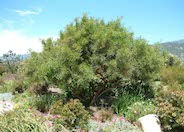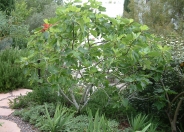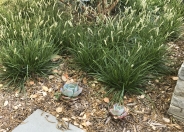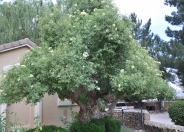
Common name: African Sumac
Botanical name: Rhus lancea
This small, evergreen tree grows slowly to 25' and exhibits an open, spreading habit. Its leaves are dark green, glossy, and divided into 3 willow-like leaflets 4"-5" long. The bark has a dark red color. The tree has males and females. It often has a drooping habit and is prone to Texas Root Rot.

Common name: Edible Fig
Botanical name: Ficus carica
This small tree reaches 20' tall and wide. It does best in rich, fertile, well draining, moist soil with full to part sun. It does not tolerate frost however, there are some cultivars that may survive cold winters. Leaves are deciduous, green and large and lobed. It produces wonderful figs that are green, turning brownish red color in late summer or early fall. Fallen fruit is messy. Mature trees have smooth, silvery bark. Considered invasive in California.

Common name: Autumn Moor Grass
Botanical name: Sesleria autumnalis
A small, mounding grass with yellow-green leaves that reaches 12" high. In the fall, it sends up narrow flower stems that have a silvery-white inflorescence. When planted in masses, it has a striking appearance. It is drought tolerant.

Common name: Blue Elderberry
Botanical name: Sambucus mexicana
The Blue Elderberry is a deciduous shrub that grows 4'-10' tall or tree that reaches up to 40' high. The leaves of this plant have 5-9 leaflets with white spring flower clusters developing into blue berries. The Blue Elderberry is a native to California, is drought tolerant and is a beneficial insect plant.
-Cornflower Farms